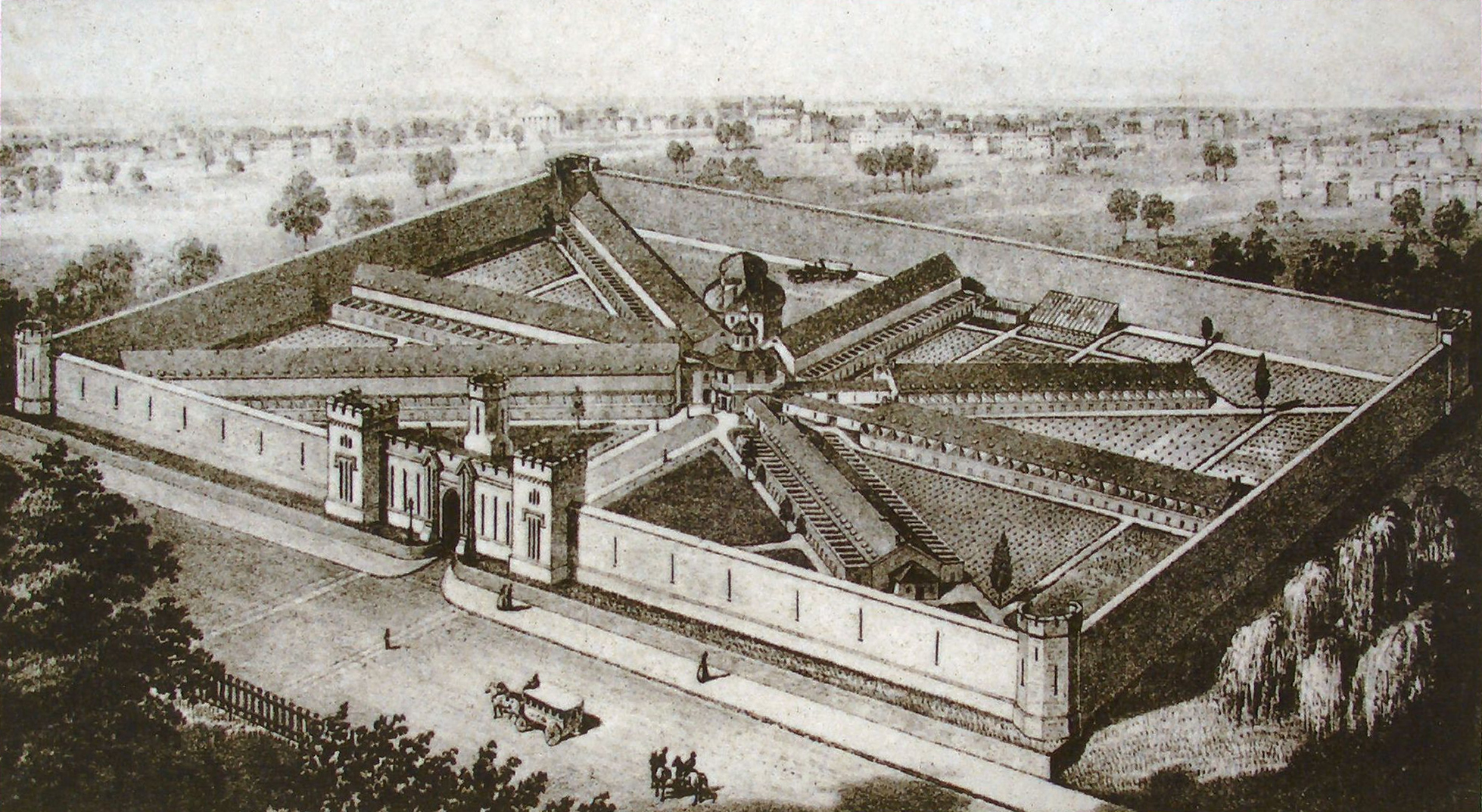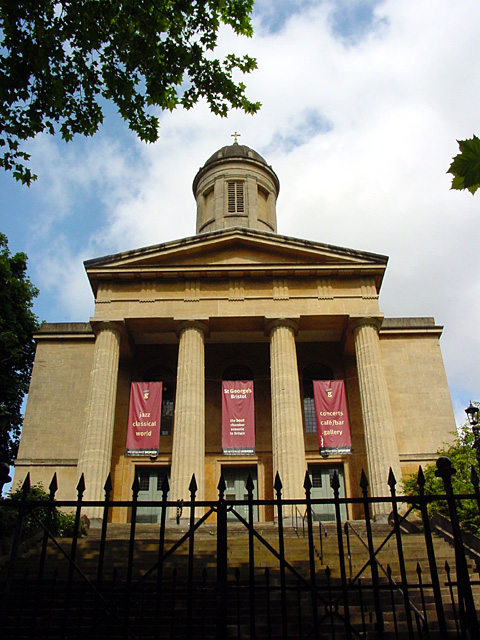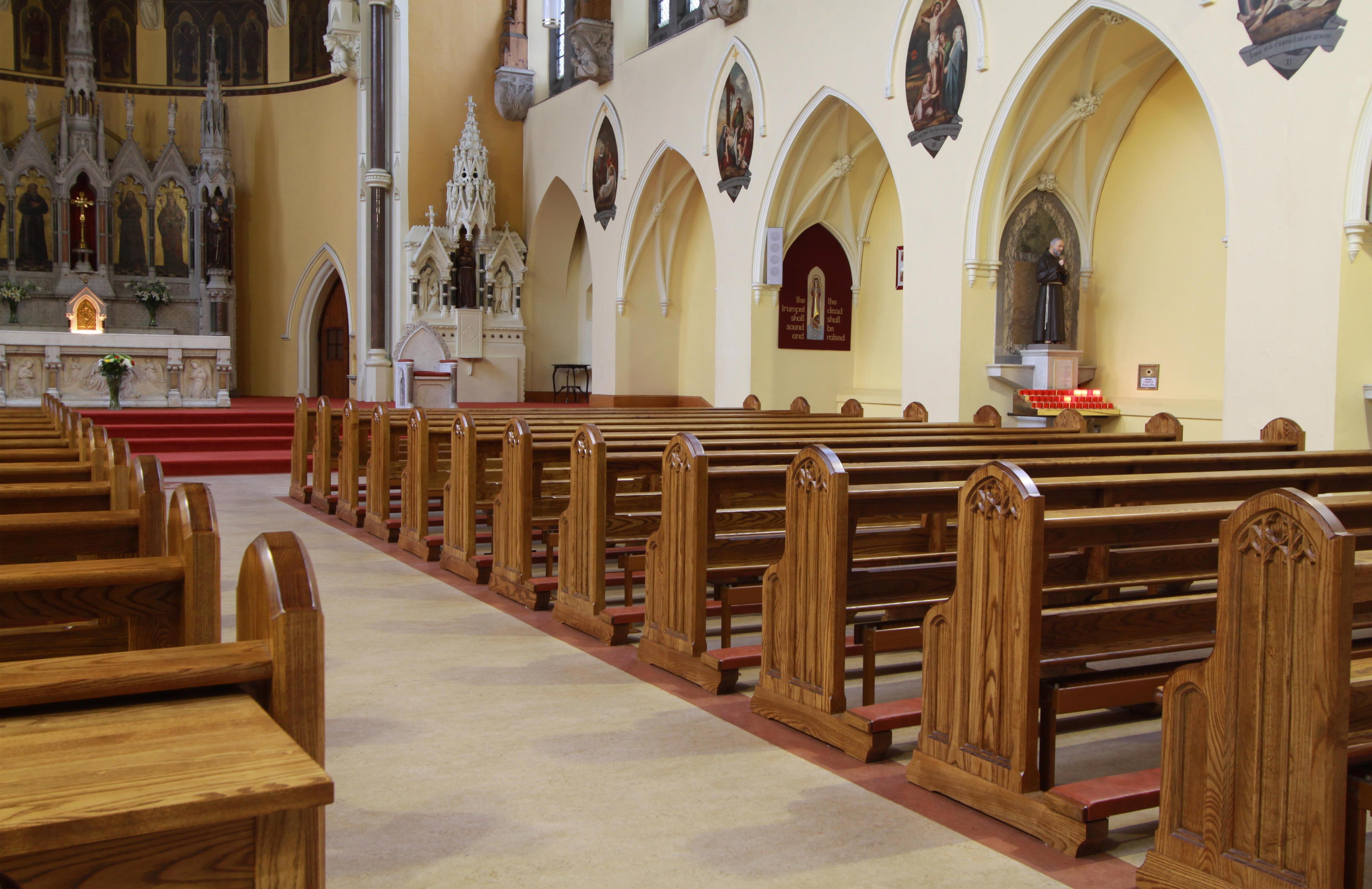|
St John The Evangelist's Church, Chichester
St John the Evangelist's Church is a redundant Anglican church in the cathedral city of Chichester in West Sussex, England. Built in 1812 to the design of James Elmes as a proprietary chapel, the octagonal white-brick "evangelical preaching house" reflects the early 19th-century ideals of the Church of England's evangelical wing before High church movements such as the Cambridge Camden Society changed ideas on church design. The Diocese of Chichester declared it redundant in 1973. Although worship no longer takes place in the building, its theatre-like design has made it a popular venue for concerts and musical events. The church is a Grade I Listed building. History Chichester, the county town of West Sussex, is an ancient settlement at the junction of several Roman and medieval roads. Roman walls encircle the heart of the city, which is divided into quadrants by straight streets with a market at the centre. Its cathedral, the seat of the Bishop of Chichester, makes Chich ... [...More Info...] [...Related Items...] OR: [Wikipedia] [Google] [Baidu] |
Chichester
Chichester () is a cathedral city and civil parish in West Sussex, England.OS Explorer map 120: Chichester, South Harting and Selsey Scale: 1:25 000. Publisher:Ordnance Survey – Southampton B2 edition. Publishing Date:2009. It is the only city in West Sussex and is its county town. It was a Roman and Anglo-Saxon settlement and a major market town from those times through Norman and medieval times to the present day. It is the seat of the Church of England Diocese of Chichester, with a 12th-century cathedral. The city has two main watercourses: the Chichester Canal and the River Lavant. The Lavant, a winterbourne, runs to the south of the city walls; it is hidden mostly in culverts when close to the city centre. History Roman period There is no recorded evidence that the city that became Chichester was a settlement of any size before the coming of the Romans. The area around Chichester is believed to have played a significant part during the Roman invasion of AD 43, ... [...More Info...] [...Related Items...] OR: [Wikipedia] [Google] [Baidu] |
County Town
In the United Kingdom and Ireland, a county town is the most important town or city in a county. It is usually the location of administrative or judicial functions within a county and the place where the county's members of Parliament are elected. Following the establishment of the English county councils in 1889, the headquarters of the new councils were usually located in the county town of each county. However, the concept of a county town pre-dates the establishment of these councils. The concept of a county town is ill-defined and unofficial. Some counties have their administrative bodies located elsewhere. For example, Lancaster is the county town of Lancashire, but the county council is located in Preston. Some county towns are no longer situated within the administrative county because of changes in the county's boundaries. For example, Nottingham is administered by a unitary authority separate from the rest of Nottinghamshire. UK county towns, pre-19th-century refor ... [...More Info...] [...Related Items...] OR: [Wikipedia] [Google] [Baidu] |
John Haviland
John Haviland (15 December 1792 – 28 March 1852) was an English-born American architect who was a major figure in American Neo-Classical architecture, and one of the most notable architects working from Philadelphia in the 19th century. Biography Born 15 December 1792, at Gundenham, near Wellington, England, Haviland was apprenticed in 1811 to a London architect. In 1815 he unsuccessfully pursued an appointment to the Russian Imperial Corps of Engineers. In Russia, however, he met George von Sonntag and John Quincy Adams, who encouraged him to work in the United States. He arrived in Philadelphia in 1816, and soon established himself as one of the few professional architects in the city. By 1818, Haviland produced a book, ''The Builder's Assistant'', which appeared in three volumes over several years. This publication was one of the earliest architectural pattern books written and published in North America, and likely the first to include Greek and Roman classical orders. ... [...More Info...] [...Related Items...] OR: [Wikipedia] [Google] [Baidu] |
Curate
A curate () is a person who is invested with the ''care'' or ''cure'' (''cura'') ''of souls'' of a parish. In this sense, "curate" means a parish priest; but in English-speaking countries the term ''curate'' is commonly used to describe clergy who are assistants to the parish priest. The duties or office of a curate are called a curacy. Etymology and other terms The term is derived from the Latin ''curatus'' (compare Curator). In other languages, derivations from ''curatus'' may be used differently. In French, the ''curé'' is the chief priest (assisted by a ''vicaire'') of a parish, as is the Italian ''curato'', the Spanish ''cura'', and the Filipino term ''kura paróko'' (which almost always refers to the parish priest), which is derived from Spanish. Catholic Church In the Catholic Church, the English word "curate" is used for a priest assigned to a parish in a position subordinate to that of the parish priest. The parish priest (or often, in the United States, the "pastor ... [...More Info...] [...Related Items...] OR: [Wikipedia] [Google] [Baidu] |
Diocese
In Ecclesiastical polity, church governance, a diocese or bishopric is the ecclesiastical district under the jurisdiction of a bishop. History In the later organization of the Roman Empire, the increasingly subdivided Roman province, provinces were administratively associated in a larger unit, the Roman diocese, diocese (Latin ''dioecesis'', from the Greek language, Greek term διοίκησις, meaning "administration"). Christianity was given legal status in 313 with the Edict of Milan. Churches began to organize themselves into Roman diocese, dioceses based on the Roman diocese, civil dioceses, not on the larger regional imperial districts. These dioceses were often smaller than the Roman province, provinces. Christianity was declared the Empire's State church of the Roman Empire, official religion by Theodosius I in 380. Constantine the Great, Constantine I in 318 gave litigants the right to have court cases transferred from the civil courts to the bishops. This situ ... [...More Info...] [...Related Items...] OR: [Wikipedia] [Google] [Baidu] |
Commissioners' Church
A Commissioners' church, also known as a Waterloo church and Million Act church, is an Anglican church in the United Kingdom built with money voted by Parliament as a result of the Church Building Acts of 1818 and 1824. The 1818 Act supplied a grant of money and established the Church Building Commission to direct its use, and in 1824 made a further grant of money. In addition to paying for the building of churches, the Commission had powers to divide and subdivide parishes, and to provide endowments. The Commission continued to function as a separate body until the end of 1856, when it was absorbed into the Ecclesiastical Commission. In some cases the Commissioners provided the full cost of the new church; in other cases they provided a partial grant and the balance was raised locally. In total 612 new churches were provided, mainly in expanding industrial towns and cities. Title The First Parliamentary Grant for churches amounted to £1 million (equivalent to £ in ), ... [...More Info...] [...Related Items...] OR: [Wikipedia] [Google] [Baidu] |
Nonconformist (Protestantism)
In English church history, the Nonconformists, also known as a Free Church person, are Protestant Christians who did not "conform" to the governance and usages of the established church, the Church of England (Anglican Church). Use of the term in England was precipitated after the Restoration of the Stuart monarchy in 1660, when the Act of Uniformity 1662 renewed opposition to reforms within the established church. By the late 19th century the term specifically included other Reformed Christians ( Presbyterians and Congregationalists), plus the Baptists, Brethren, Methodists, and Quakers. The English Dissenters such as the Puritans who violated the Act of Uniformity 1559 – typically by practising radical, sometimes separatist, dissent – were retrospectively labelled as Nonconformists. By law and social custom, Nonconformists were restricted from many spheres of public life – not least, from access to public office, civil service careers, or degrees at university � ... [...More Info...] [...Related Items...] OR: [Wikipedia] [Google] [Baidu] |
A Simple Altar Within St John's Chapel, Chichester - Geograph
A, or a, is the first letter and the first vowel of the Latin alphabet, used in the modern English alphabet, the alphabets of other western European languages and others worldwide. Its name in English is ''a'' (pronounced ), plural ''aes''. It is similar in shape to the Ancient Greek letter alpha, from which it derives. The uppercase version consists of the two slanting sides of a triangle, crossed in the middle by a horizontal bar. The lowercase version can be written in two forms: the double-storey a and single-storey ɑ. The latter is commonly used in handwriting and fonts based on it, especially fonts intended to be read by children, and is also found in italic type. In English grammar, " a", and its variant " an", are indefinite articles. History The earliest certain ancestor of "A" is aleph (also written 'aleph), the first letter of the Phoenician alphabet, which consisted entirely of consonants (for that reason, it is also called an abjad to distinguish it fro ... [...More Info...] [...Related Items...] OR: [Wikipedia] [Google] [Baidu] |
Pews Within St John's Chapel, Chichester - Geograph
A pew () is a long bench seat or enclosed box, used for seating members of a congregation or choir in a church, synagogue or sometimes a courtroom. Overview The first backless stone benches began to appear in English churches in the thirteenth century, originally placed against the walls of the nave. Over time, they were brought into the centre of the room, first as moveable furniture and later fixed to the floor. Wooden benches replaced the stone ones from the fourteenth century and became common in the fifteenth. Churches were not commonly furnished with permanent pews before the Protestant Reformation. The rise of the sermon as a central act of Christian worship, especially in Protestantism, made the pew a standard item of church furniture. Hence the use or avoidance of pews could be used as a test of the high or low character of a Protestant church: describing a mid-19th century conflict between Henry Edward Manning and Archdeacon Hare, Lytton Strachey remarks with ch ... [...More Info...] [...Related Items...] OR: [Wikipedia] [Google] [Baidu] |
British History Online
''British History Online'' is a digital library of primary and secondary sources on medieval and modern history of Great Britain and Ireland. It was created and is managed as a cooperative venture by the Institute of Historical Research, University of London and the History of Parliament Trust. Access to the majority of the content is free, but other content is available only to paying subscribers. The content includes secondary sources such as the publications of The History of Parliament, the Royal Commission on the Historical Monuments of England, the Calendar of Close Rolls, ''Survey of London'' and the ''Victoria County History''; and major published primary sources such as ''Letters and Papers of the Reign of Henry VIII'' and the ''Journals'' of the House of Lords and House of Commons. The places covered by ''British History Online'' are: British History Online began with a one-year pilot project in 2002 (Version 1.0), and Version 5.0 was launched in December 2014. Versi ... [...More Info...] [...Related Items...] OR: [Wikipedia] [Google] [Baidu] |
Victoria County History
The Victoria History of the Counties of England, commonly known as the Victoria County History or the VCH, is an English history project which began in 1899 with the aim of creating an encyclopaedic history of each of the historic counties of England, and was dedicated to Victoria of the United Kingdom, Queen Victoria. In 2012 the project was rededicated to Elizabeth II, Queen Elizabeth II in celebration of her Diamond Jubilee year. Since 1933 the project has been coordinated by the Institute of Historical Research in the University of London. History The history of the VCH falls into three main phases, defined by different funding regimes: an early phase, 1899–1914, when the project was conceived as a commercial enterprise, and progress was rapid; a second more desultory phase, 1914–1947, when relatively little progress was made; and the third phase beginning in 1947, when, under the auspices of the Institute of Historical Research, a high academic standard was set, and pr ... [...More Info...] [...Related Items...] OR: [Wikipedia] [Google] [Baidu] |
Bishop Of Chichester
The Bishop of Chichester is the ordinary of the Church of England Diocese of Chichester in the Province of Canterbury. The diocese covers the counties of East and West Sussex. The see is based in the City of Chichester where the bishop's seat is located at the Cathedral Church of the Holy Trinity. On 3 May 2012 the appointment was announced of Martin Warner, Bishop of Whitby, as the next Bishop of Chichester. His enthronement took place on 25 November 2012 in Chichester Cathedral. The bishop's residence is The Palace, Chichester. Since 2015, Warner has also fulfilled the diocesan-wide role of alternative episcopal oversight, following the decision by Mark Sowerby, then Bishop of Horsham, to recognise the orders of priests and bishops who are women. Between 1984 and 2013, the Bishop of Chichester, in addition to being the diocesan bishop, also had specific oversight of the Chichester Episcopal Area (the then Archdeaconry of Chichester), which covered the coastal region of We ... [...More Info...] [...Related Items...] OR: [Wikipedia] [Google] [Baidu] |







